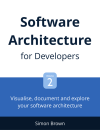C4 Lightweight Software Architecture Description Method¶
Introduction¶
Big design up front is dumb, but doing no design up front is even dumber. Dave Thomas
The C4 Model is a lightweight software architecture description method. It consists of a set of 4 diagrams that describe the static structure of a software system.
Overall, it strives for clarity and communication of the story, and follows Shneiderman’s mantra:
Overview first, zoom and filter, then details-on-demand
It is not formal UML e.g. the UML actor stickman is deliberately not used as it causes confusion between a person or a system.

The 4 C’s¶
The 4C’s |
|
|---|---|
Context |
A high-level diagram that sets the scene; including key system dependencies and people (actors/roles/personas/etc). Context diagrams are standard in software engineering (even if not used often). |
Container |
A container diagram shows the high-level technology choices, how responsibilities are distributed across them and how the containers communicate. |
Component |
For each container, a component diagram lets you see the key logical components and their relationships. 4. |
Classes (or Code) |
This is optional and is the lowest level of detail. |
CheatSheet¶
The CheatSheet gives a good summary of the C4 model and diagrams.
Video Presentation¶
See youtube video from NDC2017 conference by Simon Brown on C4 for visualisation.
Books¶
These books, written by [@simonbrown](https://twitter.com/simonbrown), are available to buy from https://leanpub.com/visualising-software-architecture.

